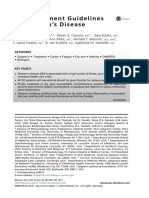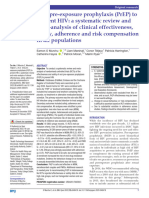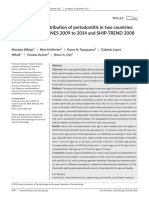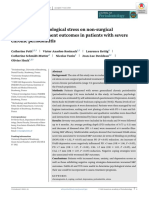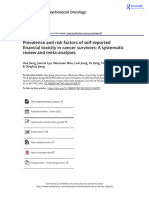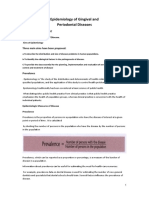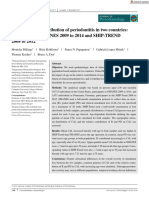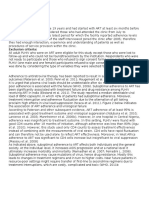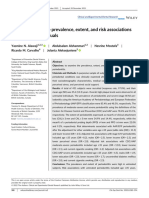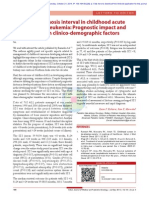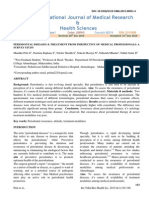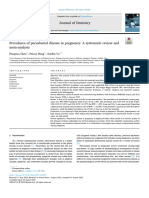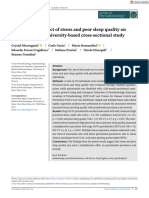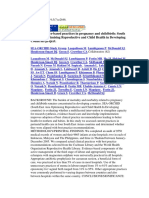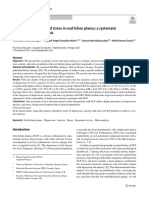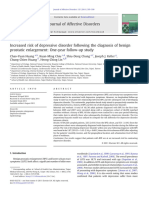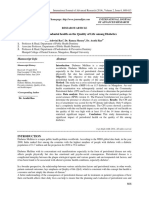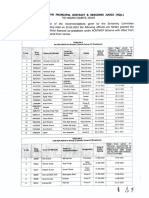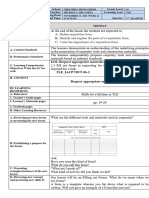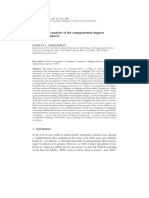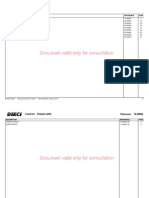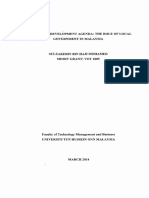Effects of Risk Factors On Periodontal Disease Defined by Calibrated Community Periodontal Index and Loss of Attachment Scores
Effects of Risk Factors On Periodontal Disease Defined by Calibrated Community Periodontal Index and Loss of Attachment Scores
Uploaded by
inkaCopyright:
Available Formats
Effects of Risk Factors On Periodontal Disease Defined by Calibrated Community Periodontal Index and Loss of Attachment Scores
Effects of Risk Factors On Periodontal Disease Defined by Calibrated Community Periodontal Index and Loss of Attachment Scores
Uploaded by
inkaOriginal Title
Copyright
Available Formats
Share this document
Did you find this document useful?
Is this content inappropriate?
Copyright:
Available Formats
Effects of Risk Factors On Periodontal Disease Defined by Calibrated Community Periodontal Index and Loss of Attachment Scores
Effects of Risk Factors On Periodontal Disease Defined by Calibrated Community Periodontal Index and Loss of Attachment Scores
Uploaded by
inkaCopyright:
Available Formats
DR LI-SHENG CHEN (Orcid ID : 0000-0001-9750-3015)
Accepted Article
Article type : Original Manuscript
Effects of Risk Factors on Periodontal Disease Defined by Calibrated
Community Periodontal Index and Loss of Attachment Scores
Chiu-Wen Su1, Amy Ming-Fang Yen2,3, Hongmin Lai4,5 ,Yungling Lee6, Hsiu-Hsi Chen6 ,
Sam Li-Sheng Chen2,3
1. Big Data Research Center, Changhua Christian Hospital
2. School of Oral Hygiene, College of Oral Medicine, Taipei Medical University, Taipei,
Taiwan
3. Oral Health Care Research Center, College of Oral Medicine, Taipei Medical University,
Taipei, Taiwan
4. Department of Dentistry, Shuang-Ho Hospital, Taipei Medical University, New Taipei
City
5. Taiwan Dental Health Care Organization, Taiwan
6. Institute of Epidemiology and Prevention Medicine, College of Public Health, National
Taiwan University, Taipei, Taiwan
This article has been accepted for publication and undergone full peer review but has not
been through the copyediting, typesetting, pagination and proofreading process, which may
lead to differences between this version and the Version of Record. Please cite this article as
doi: 10.1111/odi.12678
This article is protected by copyright. All rights reserved.
Running title: Measurement errors in effect size of PD
Accepted Article
Keywords: Community Periodontal Index; Loss Attachment; Sensitivity and Specificity;
Outcome Measurement Error; Risk Factor; Validation Study
Correspondence and reprint request to: Dr. Sam Li-Sheng Chen
School of Oral Hygiene, College of Oral Medicine, Taipei Medical University, No.250,
Wuxing St., Taipei 11031, Taiwan. Tel: 02-27361661 ext 5211, Fax: 02-27362295, E-mail:
samchen@tmu.edu.tw/Professor Hsiu-Hsi Chen
Graduate Institute of Epidemiology and Prevention Medicine, College of Public Health,
National Taiwan University, Room 533, No. 17, Hsuchow Road, Taipei, 100, Taiwan., Tel:
+886-2-33668033, Fax: +886-2-23587707, E-mail:chenlin@ntu.edu.tw
Abstract
Objectives: We evaluated whether and how the effects of risk factors on periodontal disease
(PD) were modified by measurement errors using community periodontal index (CPI) and
loss attachment (LA) in the community-based survey.
Methods: A pilot validation study was performed to estimate the rates of false negative and
false positive for both CPI and LA in 31 subjects from different regions using measurements
from 12 well-trained dentists and a senior periodontist as a gold standard. Afterward, a
Taiwanese nationwide survey was conducted by enrolling 3860 participants to estimate the
effect of each risk factor on PD calibrated with both sensitivity and specificity of two indices.
This article is protected by copyright. All rights reserved.
Results: The values obtained for the sensitivity to false positive ratio for CPI ranged widely
Accepted Article
from 1.12 to 7.71, indicating regional variation in both errors. The calibrated adjusted odds
ratio for smoking versus non-smoking was higher than the uncalibrated odds ratio for PD
defined by CPI (2.75(2.01, 3.77) versus 2.02(1.63, 2.52)) and LA (3.85(2.44, 6.13) versus
1.93(1.47, 2.54)) scores. Similar underestimation was noted for other risk factors.
Conclusion: The effects of risk factors on PD measured using CPI and LA in a large
population-based survey were underestimated without correcting for measurement errors.
Introduction
Periodontal disease (PD) is an insidious and progressive ailment with clinical
presentations varying from mild symptoms and signs (such as gingival bleeding and calculus),
to various degrees of mobility, and finally loss of tooth. To detect PD earlier, the community
periodontal index (CPI) and loss of attachment (LA) are often used to measure dental pocket
depth and destruction of supporting tissue of the teeth and reflect disease severity. More
importantly, CPI is recommended by the WHO to use as an indicator of early PD for
individuals 35 years and older as a part of large community-based screening programmes.
In addition to its multistage and progressive properties, PD is characterized as a
multifactorial chronic disease. Elucidating risk factors responsible for PD is therefore
important for strengthening primary prevention of PD (Petersen et al, 2005). Numerous
This article is protected by copyright. All rights reserved.
previous studies have identified a constellation of causative risk factors, including male
Accepted Article
gender, old age, smoking, education, and comorbidities such as type 2 diabetes and obesity
(Haber et al, 1993; Jan Bergström and Preber, 1994; Kinane and Chestnutt, 2000; Lai et al,
2007; Wang et al, 2009; Lai et al, 2015).
While these epidemiological studies have reported the effect sizes (often reported by
odds ratio or relative risk) of risk factors associated with PD, it is argued that measurement
errors (false negative and false positive) in CPI or LA may affect these estimations. The effect
of measurement errors on the evaluation of risk factors for PD measured by CPI or LA may
not be a serious problem in clinical studies because if PD is severe, its diagnosis is unlikely to
be affected by measurement errors. However, the misclassification of PD, particularly when
examined by even well-trained general dentists, may result in either an underestimation or
overestimation of the effect sizes for the risk factors of interest in the setting of a community
survey in which many of the participants may be pre-symptomatic PD cases.
At this time, few studies have been conducted to address this issue. A previous
Taiwanese study of a large-scale community-based survey, targeted to residents aged 18 years
and older, used CPI and LA, as measured by a group of trained general dentists, to assess the
prevalence of PD and a collection of conventional risk factors. These study characteristics
render it a candidate study for assessing the impact of measurement errors on effect size. The
aim of this study was to apply a two-stage design: the first stage included a pilot validation
This article is protected by copyright. All rights reserved.
study conducted to estimate the rates of false negative and false positive results for the CPI
Accepted Article
and LA measured by the examiners, and the second stage used these estimations of
measurement errors to correct the effect sizes of the risk factors associated with PD based on
the calibrated CPI and LA measured by the same examiners in a large-scale community-based
survey to assess whether measurement errors underestimated or overestimated the effect sizes
of each risk factor.
Materials and Methods
Study design
In the current study, we used a two-stage study design to estimate sensitivity and
specificity. In the first stage, we conducted a validation study to calibrate the discrepancy in
CPI and LA measurement between the gold standard (a senior periodontist, Lai H) and
dentists after professional training in PD. The estimated sensitivity and specificity from this
pilot study were used to calibrate the association between risk factors and PD obtained from
the main study, a nationwide survey. The periodontal examination was measured by CPI
(WHO, 1997). The examination consisted of CPI scores in the following five categories:
healthy, gingival bleeding, calculus, shallow pockets of 4-5 mm and deep pockets of 6 mm or
deeper (Ainamo et al, 1982). All participants provided informed consent after receiving
sufficient information. This study was approved by the Joint Institutional Review Board of
Taipei Medical University (TMUJIRB No.201207011).
This article is protected by copyright. All rights reserved.
Validation study
Accepted Article
General dentists who participated in a nationwide survey of periodontal disease were
invited to participate in a validation study comparing their measurements of CPI and LA with
those taken by a senior dentist specializing in periodontology (gold standard). Two trained
dentists selected from each area to participate in the nationwide survey (6 areas: two northern,
one central, two southern, and one eastern area of Taiwan), and one gold standard dentist
examined a total of 31 subjects; these data were included in the analysis of the intra- and
inter-rater reliability of the CPI and LA measurements. We excluded subjects that had
undergone scaling or treatment for periodontitis in two months before calibration. Each
subject was examined by both the trained general and gold standard dentists. All the teeth of
each subject were examined by the different raters at six conventional sites: mesiobuccal,
mid-buccal, disto-buccal, mesiolingual, mid-lingual, and disto-lingual. At each site, CPI and
LA score was measured and recorded. The highest score of all the sites in each sextant was
treated as the representative of that sextant.
Nationwide survey with calibration
The main objective of the nationwide survey, commissioned by the Health Promotion
Administration, Ministry of Health and Welfare, Taiwan in 2008, was to explore the
prevalence and severity of periodontal disease and its association with oral hygiene, lifestyle,
This article is protected by copyright. All rights reserved.
and other risk factors in adults aged 18 years and older. The details of this study have been
Accepted Article
described in full elsewhere (Lai et al, 2015). The nationwide survey invited 13 dentists and
one gold standard dentist to measure the sextant-level CPI and LA for 4601 subjects from
different regions. As one dentist did not complete the calibration stage, we excluded data
related to that dentist, leaving twelve dentists and one gold standard dentist and their
measurements on 3860 subjects (17,244 sextants) for inclusion in the current study. These
data were used to calculate the uncalibrated and calibrated ORs for the association between
the risk factors and PD with simultaneous consideration of the correlated properties of
sextant-level data from the same subject or the same region using the following Bayesian
hierarchical random-effect model.
Risk Factors
For periodontal participants in the main survey, we designed a structured questionnaire
to collect information on a constellation of variables, including demographic variables;
anthropometric measurements, such as height and weight; lifestyle factors, including cigarette
smoking, alcohol consumption, and betel-quid chewing; and personal diseases, such as type 2
diabetes mellitus. The questionnaire was administered by public health nurses between 2007
and 2008 in the CIS programme.
This article is protected by copyright. All rights reserved.
Definition of underestimation and overestimation
Accepted Article
In epidemiological studies, biases due to these measurement errors are classified into
differential and non-differential. If the effect size is away from the null hypothesis (no
association expressed by OR=1), it is a differential misclassification and often results in
overestimation of effect size if uncorrected. On the other hand, if the effect size is towards the
null hypothesis, it is called non-differential misclassification and often results in
underestimation if uncorrected.
We conducted a validation study to assess the possibility of measurement errors. The
Supplementary provides an example demonstrating how the effect size of smoking on the
odds of PD measured by CPI was substantially changed after correcting for the measurement
errors; these results were classified as non-differential misclassification due to the
underestimation of the effect size of smoking, which inflated from 2 to 4.43 for the
uncalibrated and calibrated odds ratios, respectively. This Bayesian hierarchical model may
be further applied to large-scale epidemiological surveys to calibrate the odds ratios of other
risk factors.
Statistical analyses
In order to measure the impact of the risk factors on PD, the attributable proportion
(AR) and population attributable proportion (PAR) were used in the analysis. AR was defined
as the proportion of disease in the exposed group that could be attributed by a given risk
factor. The AR was formally written as
This article is protected by copyright. All rights reserved.
Attributable proportion=
Accepted Article
PAR is the proportional reduction in population disease that would occur if exposure to
a risk factor were reduced to an alternative exposure scenario. The formula was written as
( %)×( )
Population attributable proportion=( ( %)×( ))
In the calibration study, the estimates of sensitivity and specificity comparing PD status
measured as by participating trained dentists and PD status measured by the gold standard
dentist and their confidence intervals following binomial distribution were reported. For the
nationwide survey, we first reported the distribution of sextant-level PD measured by the
participating trained dentists by personal characteristics, including gender, age, education
level, body mass index (BMI), type 2 diabetes mellitus (DM), and lifestyle factors such as
cigarette smoking and alcohol consumption. To take into account the correlated property of
sextant-level data from the same subject or the same dentist, we applied a Bayesian
hierarchical model with the incorporation of correlated properties (Yen, 2006) and
measurement errors to estimate the calibrated odds ratio between risk factors and PD; we
applied this hierarchical univariate logistic regression model with a random intercept,
accounting for different baselines in the same cluster, to estimate the crude odds ratio (cOR)
for the effect of each risk factor on PD. The random intercept term was assumed to follow a
normal distribution centred at zero with a standard deviation, denoted by σ, which was used
to test whether the random effect is statistically significant. Finally, the hierarchical
This article is protected by copyright. All rights reserved.
multivariable logistic regression models with and without calibration were further applied to
Accepted Article
calculate the calibrated odds ratio (OR) adjusting for confounding factors with each other. We
also calculated attributable proportion (AR) and population attributable proportion (PAR) for
each risk factor given the estimated adjusted odds ratios before and after calibration. The
estimation of the hierarchical models was accomplished using the Markov chain Monte Carlo
simulation underpinning the developed Bayesian directed acyclic graphic model and
Windows-based Bayesian Inference Using Gibbs Sampling (WinBugs) software
(Spiegelhalter et al, 2004). The 95% confidence interval was extracted from the posterior
distribution of each parameter and reported for the assessment of statistical significance.
Results
The overall sensitivity and specificity of CPI measurement at the sextant level were
0.73 and 0.82. The corresponding figures were 0.67 and 0.73 for LA measurement and 0.78
and 0.69 for CPI and LA. The number of sextants by status of PD with CPI and LA defined
by the gold standard and by participating trained dentists who were involved in the
nationwide survey, and the corresponding estimates of sensitivity and specificity are shown in
Supplementary sTable 1. The results show that measurement errors varied by regions and had
a wide range of positive likelihood ratios (sensitivity/false positive) from 1.12 to 7.71 for CPI
and from 0.92 to 5.71 for LA.
This article is protected by copyright. All rights reserved.
Table 1 shows the descriptive data for the nationwide survey on periodontal disease at
Accepted Article
the sextant-level with CPI and LA scores. Table 2 shows the comparisons of crude and
adjusted odds ratios (ORs) with PD defined by CPI ≥3 or LA≥1 as the outcome between the
uncalibrated and the calibrated models. The effect sizes for calibrated cORs for each variable
in the univariate analysis were more considerably further away from the null (cOR=1),
displaying so-called non-differential misclassification, in the calibrated model in comparison
with the corresponding uncalibrated model, suggesting an underestimation of the influence of
each variable on PD in the absence of calibration. Taking smoking as an example, the cOR
for the odds of PD for smokers vs. non-smokers was two times greater with calibration than
without calibration and increased from 3.42 (2.81, 4.17) to 6.50 (4.65, 9.39). Similar
underestimations of cORs were also noted for other variables with various extents of
non-differential misclassification.
Table 2 also shows that the influence of such non-differential misclassification on the
underestimation of effect sizes was attenuated by adjustment, but the tendency towards
non-differential misclassification still remained in the multivariate analysis with adjustment
for variables with (multivariate model 2) and without (multivariate model 1) incorporation of
alcohol drinking.
This article is protected by copyright. All rights reserved.
The underestimation of effect sizes with PD defined by CPI ≥3 alone is listed in Table
Accepted Article
3. Elevated effect sizes for calibrated and uncalibrated ORs and 95% confidence intervals
were noted for the association between smoking and PD in the univariate analysis (2.62 (2.19,
3.18) to 4.29 (3.22, 5.84)) and in multivariate analysis 2.02 (1.63, 2.52) to 2.75 (2.01, 3.77).
The calibrated OR was still consistently higher than the uncalibrated OR using different
cut-offs of CPI score (Supplementary sTable 2). These findings suggest such a
non-differential misclassification is unlikely to be modified by different definitions of PD.
Table 4 shows the corresponding results using a LA score ≥1 alone. It is interesting to
note that the alteration of effect size was greater than that observed using CPI alone. However,
such a change was ameliorated when all the variables were considered in the multivariate
analysis.
Table 5 shows the comparison of the proportion of risk for PD attributed to each selected
variable at individual level (AR) and population level (PAR) between the uncalibrated and the
calibrated estimates. For smoking, for example, the estimated AR and PARs increased after
calibration by 14% and 10% for CPI and by 26% and 21% for LA, respectively. The
corresponding figures for other variables were increased by 0~10% of PAR for CPI and by
9~21% of PAR for LA.
This article is protected by copyright. All rights reserved.
Discussion
Accepted Article
Because periodontal probing measurements depend on a hand-held probe, the outcome
measurements are subject to a dentist’s subjective judgement and periodontal expertise (such
as probing force and position). Therefore, the potential probability of measurement error for
PD is greater than for other diseases when community-based screening for early detection of
PD is conducted. This may explain why prevalence of PD varied from study to study.
As expected, the periodontal measurement errors in our validation study varied with
region. There were higher sensitivities in the northern and eastern area but more false
negative cases in the central area and two southern areas. For periodontal disease prevalence
surveys, the measurement errors exist across dentists. Therefore, before a nationwide survey,
we had conducted a validation study to assess the measurement errors in the measures for PD
and use them for calibration to improve the accuracy of PD prevalence estimation. Moreover,
the magnitude of the effects of the risk factors on periodontal disease was also affected.
The results of the effect of the calibration of the estimation of effect size for each risk
factor associated with the risk for PD was consistently demonstrated as non-differential
misclassification using either CPI or loss of attachment (LA) score. Specifically, the
calibrated OR was generally higher than the uncalibrated OR, although the underlying effect
This article is protected by copyright. All rights reserved.
sizes in terms of OR varied with different cut-offs for CPI score. These findings suggest that
Accepted Article
non-differential misclassification is unlikely to be modified due to using different outcomes
to define PD.
The implications of our findings are two-fold for prevention and treatment of PD. First,
if the effect of a risk factor, for example smoking, on PD is underestimated without
calibration, the contribution of this risk factor may be neglected and primary prevention of
PD may not target these risk factors. This can be easily observed from our AR and PAR
results. Second, the biased estimated odds ratio may also affect the risk stratification of PD in
the underlying population and, in turn, may lead to inaccurate individual risk prediction for
PD.
One might be interested to know whether the measurement errors are different by
different sites. Suppose senior periodontist are less likely to include such kind of gingival
recession as the outcome of CPI, the sensitivity of mid-buccal sites is supposed to be lower
than that of other sites in addition to the quality of professional training in the skills of CPI
and LA. It is interesting to assess the impact of measurement errors attributed to this drive
resulting from brushing. Unfortunately, we did not collect data at site-level and only at
sextant level in the main study and we could not re-analyse the data by sensitivity analysis
with and without excluding mid-buccal. However, we can check the influence of this concern
on measurement errors by examining sensitivity and specificity by different sites using data
This article is protected by copyright. All rights reserved.
from the first stage of validation study that were collected on the basis of site level. Based on
Accepted Article
the validation data on 31 participants, the sensitivity of mid-buccal site (36%) was lower than
other sites (47%) for the CPI measurements. The sensitivity of mid-buccal site (56%) was
lower than other sites (67%) for the LA measurements. The impact of lower sensitivity might
underestimate the effect size of the risk factors. However, the analysis of data on the main
study can be only limited to sextant-level due to unavailable information on site level. This is
one of our study limitations. Another limitation is that our periodontal measurements were
recorded at the sextant-level in a large-scale epidemiological study, and the measurement at
sextant-level was determined by index teeth. The highest score of all sites in each sextant was
selected as the representative of that sextant in our calibration. However, whether
measurement error at the sextant-level in the validation study can represent measurement
error in a large epidemiological study should be confirmed in future studies.
In conclusion, our study shows that the effect of measurement error on PD varied with
dentists and regions. The results of our validation study provide the basis for correcting the
effect size regarding the association between relevant correlates and PD. The estimated odds
ratio for certain risk factor (such as smoking) in association with PD was substantially
underestimated without calibration, which may also undervalue the ability of risk factor
intervention through health education to impact PD at the population level.
This article is protected by copyright. All rights reserved.
Acknowledgements
Accepted Article
The study was supported by the Department of Health, Taiwan (DOH97-HP-1304), National
Science Council (NSC 101-2314-B-038-032-MY2), and Ministry of Science and Technology,
Taiwan (MOST 104-2118-M-038-002, and MOST 105-2118-M-038-001).We gratefully
acknowledged the support and participation of the staff of the Keelung, Taipei, Changhua,
Tainan, Taitung and Matsu Health Bureau.
Conflict of Interest
The authors declare no conflicts of interest.
Author Contributions
CWS, HHC and SLC conceived the study concept and design. AMY and HL were
responsible for data analysis. AMY, HL, and YLL contributed on interpretation of the results.
CWS wrote the first draft. CWS and AMY contributed on concepts for analysis. HHC and
SLC revised the manuscript. All authors approved the MS before submission.
This article is protected by copyright. All rights reserved.
References
Accepted Article
Ainamo J, Barmes D, Beagrie G, Cutress T, Martin J, Sardo-Infirri J (1982). Development of
the World Health Organization (WHO) community periodontal index of treatment needs
(CPITN). Int Dent J 32: 281-291.
Jan Bergström, Hans Preber (1994). Tobacco Use as a Risk Factor. J Periodontol 65:545-550.
Haber J, Wattles J, Crowley M, Mandell R, Joshipura K, Kent RL (1993). Evidence for
cigarette smoking as a major risk factor for periodontitis. J Periodontol 64:16-23.
Kinane DF, Chestnutt, IG (2000). Smoking and Periodontal Disease. Critical Reviews in Oral
Biology & Medicine 11: 356-365.
Lai H, Lo MT, Wang PE, Wang TT, Chen TH, Wu GH (2007). A community-based
epidemiological study of periodontal disease in Keelung, Taiwan: a model from Keelung
community-based integrated screening programme (KCIS No. 18). J Clin Periodontol 34:
851-859.
Lai H, Su CW, Yen AM, Chiu SY, Fann JC, Wu WY, Chuang SL, Liu HC, Chen HH, Chen
LS(2015). A prediction model for periodontal disease: modelling and validation from a
National Survey of 4061 Taiwanese adults. J Clin Periodontol 42: 413-421.
Spiegelhalter D, Thomas A, Best N, Lunn D (2004). Win BUGS User Manual Version 2.0.
Cambridge, UK: MRC Biostatistics Unit.
Petersen PE, Ogawa H (2005). Strengthening the prevention of periodontal disease: theWHO
This article is protected by copyright. All rights reserved.
approach. J Periodontol 76:2187-2193.
Accepted Article
Wang TT, Chen TH, Wang PE, Lai H, Lo MT, Chen PY, Chiu SY (2009). A
population-based study on the association between type 2 diabetes and periodontal disease
in 12,123 middle-aged Taiwanese (KCIS No. 21). J Clin Periodontol 36: 372-379.
WHO. (1997). Oral Health Survey.Basic Methods, 4th edition.Geneva: WHO.
Yen AM, Liou HH, Lin HL, Chen TH (2006). Bayesian random-effect model for predicting
outcome fraught with heterogeneity--an illustration with episodes of 44 patients with
intractable epilepsy. Methods Inf Med 45:631-637.
This article is protected by copyright. All rights reserved.
Table 1 Descriptive data on nationwide survey of periodontal disease at sextant-level with
CPI score and LA score
Accepted Article
CPI ≥3 or LA≥1 CPI ≥3 LA≥1
Variable
Non-PD PD Non-PD PD Non-PD PD
Gender Female 9,237 4,251 10,684 2,804 10,899 2,589
Male 5,381 4,213 6,924 2,670 6,453 3,141
Age 18-49 9,001 3,629 10,200 2,430 10,316 2,314
Over 50 4,031 3,775 5,334 2,472 5,172 2,634
Education >9 years 8,501 3,667 9,745 2,423 9744 2,424
<=9 years 4,531 3,737 5,789 2,479 5744 2,524
BMI <25 kg/m2 9,029 4,519 10,620 2,928 10,494 3,054
2
>=25 kg/m 4,354 3,008 5,397 1,965 5,316 2,046
DM Normal 11,214 5,640 13,153 3,701 13,118 3,736
pre-DM 1,982 1,444 2,501 925 2,455 971
DM 616 656 829 443 808 464
Smoking No 11,037 5,295 12,927 3,405 12,868 3,464
Yes 2,393 2,227 3,126 1,494 2,994 1,626
Alcohol No 7,933 4,541 9,612 2,862 9,363 3,111
Drinking Yes 3,914 2,008 4,630 1,292 4,482 1,440
CPI: Community Periodontal Index
LA: Loss of Attachment
PD: Periodontal Disease
This article is protected by copyright. All rights reserved.
Table 2 Estimated adjusted odds ratio of risk factors for periodontal disease with CPI and LA
(CPI ≥3 or LA≥1) at sextant-level for univariate logistic regression model before and after
Accepted Article
calibrating measurement errors using Bayesian hierarchical model
Univariate Multivariate – Model 1 Multivariate – Model 2
Variable Uncalibrated cOR Calibrated cOR Uncalibrated aOR Calibrated aOR Uncalibrated aOR Calibrated aOR
(95% CI) (95% CI) (95% CI) (95% CI) (95% CI) (95% CI)
Gender
Male/ Female 2.64 4.37 1.76 2.05 1.83 2.21
(2.24, 3.12) (3.33, 5.89) (1.45, 2.13) (1.56, 2.70) (1.47, 2.27) (1.60, 3.09)
Age
per year 1.08 1.13 1.07 1.11 1.07 1.12
(1.07, 1.09) (1.12, 1.15) (1.06, 1.08) (1.10, 1.12) (1.06, 1.08) (1.11, 1.14)
Education
≤9/ >9 years 3.65 9.56 1.37 1.76 1.44 1.97
(3.07, 4.33) (7.03, 13.60) (1.13, 1.67) (1.32, 2.32) (1.15, 1.80) (1.43, 2.75)
BMI
≥25/<25 kg/m2 1.81 2.78 1.02 1.05 1.01 1.06
(1.53, 2.15) (2.08, 3.76) (0.86, 1.20) (0.82, 1.36) (0.83, 1.23) (0.80, 1.42)
DM
pre-DM/ Normal 1.18 1.16 1.03 1.33 0.98 1.36
(0.90, 1.57) (0.65, 2.11) (0.83, 1.29) (0.95, 1.85) (0.76, 1.27) (0.92, 2.04)
DM/ Normal 1.39 2.09 1.62 2.90 1.53 2.48
(0.89, 2.17) (0.83, 5.53) (1.15, 2.29) (1.68, 5.06) (1.05, 2.27) (1.34, 4.72)
Smoking
Yes/ No 3.42 6.50 2.00 2.76 2.00 2.81
(2.81, 4.17) (4.65, 9.39) (1.61, 2.49) (2.00, 3.84) (1.55, 2.58) (1.93, 4.10)
Alcohol Drinking
Yes/ No 0.76 0.56 1.14 1.18
-- --
(0.62, 0.93) (0.40, 0.78) (0.93, 1.40) (0.86, 1.61)
DIC -- -- 17921.9 18103.6 15268.8 15438.4
aOR: Adjusted Odds Ratio
cOR: Crude Odds Ratio
CPI: Community Periodontal Index
DIC: Deviance Information Criterion
LA: Loss of Attachment
This article is protected by copyright. All rights reserved.
Table 3 Estimated adjusted odds ratio of risk factors for periodontal disease with CPI (CPI ≥3)
at sextant-level for univariate and multivariate logistic regression model before and after
Accepted Article
calibrating measurement errors using Bayesian hierarchical model
Univariate Multivariate
Variable Uncalibrated cOR Calibrated cOR Uncalibrated aOR Calibrated aOR
(95% CI) (95% CI) (95% CI) (95% CI)
Gender
1.87 2.64 1.30 1.47
Male/ Female
(1.61, 2.19) (2.08, 3.39) (1.07, 1.57) (1.12, 1.94)
Age
1.06 1.08 1.05 1.07
per year
(1.05, 1.06) (1.07, 1.09) (1.05, 1.06) (1.06, 1.09)
Education
2.75 4.26 1.27 1.44
≤9/ >9 years
(2.33, 3.23) (3.29, 5.65) (1.04, 1.56) (1.10, 1.89)
BMI
1.56 1.99 1.10 1.15
≥25/ <25 kg/m2
(1.32, 1.86) (1.55, 2.58) (0.93, 1.32) (0.90, 1.47)
DM
1.65 2.22 0.99 1.13
pre-DM/ Normal
(1.33, 2.06) (1.62, 3.09) (0.79, 1.25) (0.82, 1.56)
3.28 6.75 1.50 2.26
DM/ Normal
(2.38, 4.56) (4.08, 11.38) (1.07, 2.10) (1.39, 3.71)
Smoking
2.62 4.29 2.02 2.75
Yes/ No
(2.19, 3.18) (3.22, 5.84) (1.63, 2.52) (2.01, 3.77)
Alcohol Drinking
0.85 0.79
Yes/ No -- --
(0.70, 1.03) (0.59, 1.08)
DIC -- -- 15917 16106.8
aOR: Adjusted Odds Ratio
cOR: Crude Odds Ratio
CPI: Community Periodontal Index
DIC: Deviance Information Criterion
This article is protected by copyright. All rights reserved.
Table 4 Estimated adjusted odds ratio of risk factors for periodontal disease with LA (LA ≥1)
at sextant-level for univariate and multivariate logistic regression model before and after
Accepted Article
calibrating measurement errors using Bayesian hierarchical model
Univariate Multivariate
Variable Uncalibrated cOR Calibrated cOR Uncalibrated aOR Calibrated aOR
(95% CI) (95% CI) (95% CI) (95% CI)
Gender
4.01 12.72 2.65 3.88
Male/ Female
(3.30, 4.91) (8.10, 21.50) (2.08, 3.38) (2.58, 6.06)
Age
1.09 1.19 1.07 1.15
per year
(1.08, 1.10) (1.17, 1.22) (1.06, 1.08) (1.13, 1.18)
Education
3.47 22.24 1.29 2.14
≤9/ >9 years
(2.81, 4.28) (13.08, 38.74) (1.00, 1.63) (1.44, 3.21)
BMI
1.82 3.03 0.91 0.86
≥25/ <25 kg/m2
(1.46, 2.28) (1.94, 4.79) (0.72, 1.14) (0.59, 1.23)
DM
2.07 8.35 0.96 1.51
pre-DM/ Normal
(1.56, 2.73) (4.42, 16.73) (0.72, 1.27) (0.93, 2.44)
5.13 48.86 1.49 3.24
DM/ Normal
(3.28, 8.06) (18.77, 148.86) (0.98, 2.25) (1.58, 6.84)
Smoking
4.22 16.28 1.93 3.85
Yes/ No
(3.26, 5.42) (9.23, 30.94) (1.47, 2.54) (2.44, 6.13)
Alcohol Drinking
0.84 0.52
Yes/ No -- --
(0.65, 1.09) (0.26, 0.99)
DIC -- -- 13968.3 14059.6
aOR: Adjusted Odds Ratio
cOR: Crude Odds Ratio
DIC: Deviance Information Criterion
LA: Loss of Attachment
This article is protected by copyright. All rights reserved.
Table 5 AR and PAR by status of PD with CPI and LA at sextant level
Accepted Article
% Uncalibrated Calibrated
Variable
Exposure aOR AR PAR aOR AR PAR
CPI ≥3 or LA ≥1
Education 0.4 1.37 27% 13% 1.75 43% 23%
BMI 0.35 1.02 2% 1% 1.05 5% 2%
pre-DM 0.16 1.03 3% 0% 1.31 24% 5%
DM 0.06 1.62 38% 4% 2.96 66% 11%
Smoking 0.22 2 50% 18% 2.86 65% 29%
CPI ≥3
Education 0.4 1.27 21% 10% 1.44 31% 15%
BMI 0.35 1.1 9% 3% 1.15 13% 5%
pre-DM 0.16 0.99 -1% 0% 1.13 12% 2%
DM 0.06 1.5 33% 3% 2.26 56% 7%
Smoking 0.22 2.02 50% 18% 2.75 64% 28%
LA ≥1
Education 0.4 1.29 22% 10% 2.14 53% 31%
BMI 0.35 0.91 -10% -3% 0.86 -16% -5%
pre-DM 0.16 0.96 -4% -1% 1.51 34% 8%
DM 0.06 1.49 33% 3% 3.24 69% 12%
Smoking 0.22 1.93 48% 17% 3.85 74% 39%
aOR: Adjusted Odds Ratio
BMI: Body Mass Index
DM: Diabetes Mellitus
CPI: Community Periodontal Index
LA: Loss of Attachment
AR (Attributable Proportion)= (Odds Ratio-1)/(Odds Ratio)
PAR(Population Attributable Proportion)= ((Exposure %)×(Odds Ratio-1))/(1+(Exposure
%)×(Odds Ratio-1))
This article is protected by copyright. All rights reserved.
You might also like
- KPIs-Bank of America Merrill Lynch White PaperDocument5 pagesKPIs-Bank of America Merrill Lynch White PaperGabriela Brito TeixeiraNo ratings yet
- PCR Vs PRADocument25 pagesPCR Vs PRADiego AzaedoNo ratings yet
- Academic Emergency Medicine - 2020 - Ebell - Accuracy of Signs and Symptoms For The Diagnosis of Community AcquiredDocument14 pagesAcademic Emergency Medicine - 2020 - Ebell - Accuracy of Signs and Symptoms For The Diagnosis of Community AcquiredOnilis RiveraNo ratings yet
- Rheumatology CPGDocument21 pagesRheumatology CPGSanNo ratings yet
- Limited-evidence-suggests-no-difference-in-implantDocument3 pagesLimited-evidence-suggests-no-difference-in-implantAnna CorreiaNo ratings yet
- Magno 2018Document25 pagesMagno 2018baridinoNo ratings yet
- PrEP MurchuDocument14 pagesPrEP MurchuSeptian 99No ratings yet
- Diagnostic and Prognostic Tests For Oral DiseasesDocument12 pagesDiagnostic and Prognostic Tests For Oral DiseasesFanella Desta RahayuNo ratings yet
- Billings Et Al-2018-Journal of Clinical PeriodontologyDocument19 pagesBillings Et Al-2018-Journal of Clinical PeriodontologyCristian CulcitchiNo ratings yet
- FDLQIDocument15 pagesFDLQIvedasree3991No ratings yet
- Influence of Psychological Stress On Non-Surgical Periodontal Treatment Outcomes in Patients With Severe Chronic PeriodontitisDocument10 pagesInfluence of Psychological Stress On Non-Surgical Periodontal Treatment Outcomes in Patients With Severe Chronic PeriodontitisAndra AgheorghieseiNo ratings yet
- Prevalence and Risk Factors of Self-Reported Financial Toxicity in Cancer Survivors A Systematic Review and Meta-AnalysesDocument19 pagesPrevalence and Risk Factors of Self-Reported Financial Toxicity in Cancer Survivors A Systematic Review and Meta-Analysesmrezab1987No ratings yet
- Epidemiology of Gingival and Periodontal DiseasesDocument7 pagesEpidemiology of Gingival and Periodontal DiseasesyeoboyNo ratings yet
- Low Disclosure of PrEP Nonadherence and HIV Risk Behaviors Associated With Poor HIV PrEP Adherence in The HPTN 067: ADAPT StudyDocument17 pagesLow Disclosure of PrEP Nonadherence and HIV Risk Behaviors Associated With Poor HIV PrEP Adherence in The HPTN 067: ADAPT StudycapawatywidyNo ratings yet
- J Clinic Periodontology - 2014 - Lang - Risk Factor Assessment Tools For The Prevention of Periodontitis Progression ADocument12 pagesJ Clinic Periodontology - 2014 - Lang - Risk Factor Assessment Tools For The Prevention of Periodontitis Progression Adaniel15056No ratings yet
- Journal of Periodontology - 2018 - Billings - Age‐dependent distribution of periodontitis in two countries Findings fromDocument19 pagesJournal of Periodontology - 2018 - Billings - Age‐dependent distribution of periodontitis in two countries Findings fromDadi SindhuNo ratings yet
- Epidemiology of Periodontal DiseasesDocument14 pagesEpidemiology of Periodontal DiseasesFrancisca DinamarcaNo ratings yet
- Oral Health Adults Screening Interventions Draft Evidence Review (1)Document114 pagesOral Health Adults Screening Interventions Draft Evidence Review (1)eduardo basanezNo ratings yet
- Development and Validation of College Students ' Tuberculosis Knowledge, Attitudes and Practices Questionnaire (CS-TBKAPQ)Document11 pagesDevelopment and Validation of College Students ' Tuberculosis Knowledge, Attitudes and Practices Questionnaire (CS-TBKAPQ)Vertavera SyaulatiaNo ratings yet
- Anxiety About Dental Treatment - A Gender IssueDocument6 pagesAnxiety About Dental Treatment - A Gender Issueyeniescamilla191213No ratings yet
- The Accuracy of Clinical Diagnosis of Oral Lesions and Patient-Specific Risk Factors That Affect DiagnosisDocument6 pagesThe Accuracy of Clinical Diagnosis of Oral Lesions and Patient-Specific Risk Factors That Affect DiagnosisAmeloblogNo ratings yet
- SB DefenseDocument31 pagesSB DefenseabenezergebrekirstosNo ratings yet
- Data SaturationDocument8 pagesData SaturationmakmgmNo ratings yet
- His 9Document158 pagesHis 9Anjum100% (6)
- International Journal of Pharmacy Practice AbstractsDocument40 pagesInternational Journal of Pharmacy Practice AbstractsFabiola NogaNo ratings yet
- Samikshya .EditedDocument8 pagesSamikshya .EditedSaru NiraulaNo ratings yet
- Cre2 8 380Document15 pagesCre2 8 380cdsd-2011No ratings yet
- Jurnal 5Document9 pagesJurnal 5raraNo ratings yet
- Postpartum Depression 1Document8 pagesPostpartum Depression 1AtharvaNo ratings yet
- Adj 12774Document5 pagesAdj 12774Irfan HussainNo ratings yet
- Symptom Diagnosis Interval in Childhood Acute Lymphoblastic Leukemia: Prognostic Impact and Association With Clinico-Demographic FactorsDocument1 pageSymptom Diagnosis Interval in Childhood Acute Lymphoblastic Leukemia: Prognostic Impact and Association With Clinico-Demographic FactorsMonica Gabriella K. TambajongNo ratings yet
- Assessing Differences in Utility Scores: A Comparison of Four Widely Used Preference-Based InstrumentsDocument10 pagesAssessing Differences in Utility Scores: A Comparison of Four Widely Used Preference-Based InstrumentsCharles QuahNo ratings yet
- Chan (2018)Document16 pagesChan (2018)Aprilla Ayu WulandariNo ratings yet
- Study DesignsDocument36 pagesStudy Designsz6f9cw8vwvNo ratings yet
- 31priti EtalDocument4 pages31priti EtaleditorijmrhsNo ratings yet
- 1 s2.0 S0300571222003098 MainDocument8 pages1 s2.0 S0300571222003098 MainRizki Yuli amandaNo ratings yet
- ScientificSummary Hta19570Document8 pagesScientificSummary Hta19570Anonymous hvOuCjNo ratings yet
- Association Between Maternal Factors and Risk of CHD in OffspringDocument20 pagesAssociation Between Maternal Factors and Risk of CHD in OffspringamaldabesariNo ratings yet
- Jurnal 2Document16 pagesJurnal 2Edwin Pasha Jr.No ratings yet
- SPARK (Artigo 30)Document6 pagesSPARK (Artigo 30)Maria Clara SalgadoNo ratings yet
- Cunningham - Perceptions of Outcomes of Orthodontic Treatment in Adolescent Patients - A Qualitative StudyDocument21 pagesCunningham - Perceptions of Outcomes of Orthodontic Treatment in Adolescent Patients - A Qualitative StudyMilton david Rios serratoNo ratings yet
- Clinical: Association Treatment OutcomesDocument9 pagesClinical: Association Treatment OutcomesAngela RamirezNo ratings yet
- Journal of Periodontology - 2023 - Marruganti - Multiplicative Effect of Stress and Poor Sleep Quality On Periodontitis ADocument10 pagesJournal of Periodontology - 2023 - Marruganti - Multiplicative Effect of Stress and Poor Sleep Quality On Periodontitis Adiaustrian yudhana santosoNo ratings yet
- Artigo 1Document13 pagesArtigo 1fisio.lumabarreiraNo ratings yet
- Risk Factors For Invasive Fungal Disease in Pediatric Cancer and Hematopoietic Stem Cell TransplantationDocument8 pagesRisk Factors For Invasive Fungal Disease in Pediatric Cancer and Hematopoietic Stem Cell Transplantationjo diNo ratings yet
- Nested Case Control StudyDocument16 pagesNested Case Control Studyqtftwkwlf100% (1)
- Health&Clinical ManagementDocument125 pagesHealth&Clinical ManagementAnjum100% (1)
- A meta-analysis on the effect of periodontal treatment onDocument9 pagesA meta-analysis on the effect of periodontal treatment onARIANA LUCIA LEON PEREZNo ratings yet
- Pinto 2020Document14 pagesPinto 2020s7ybkjhb44No ratings yet
- Huang 2019Document10 pagesHuang 2019blume diaNo ratings yet
- Artigo 2 Prevalencia ChinaDocument7 pagesArtigo 2 Prevalencia ChinaCarmen AdamesNo ratings yet
- Di Iorio - SR World Workshop 08.01.18Document62 pagesDi Iorio - SR World Workshop 08.01.18aziz alsohailNo ratings yet
- Depression Anxiety and Stress in Oral Lichen Planus A 3gx96ie7qaDocument18 pagesDepression Anxiety and Stress in Oral Lichen Planus A 3gx96ie7qatafazzal.eduNo ratings yet
- Preventive Medicine Reports: Samuel R. Bunting, Brian A. Feinstein, Aniruddha Hazra, Neeral K. Sheth, Sarah S. GarberDocument9 pagesPreventive Medicine Reports: Samuel R. Bunting, Brian A. Feinstein, Aniruddha Hazra, Neeral K. Sheth, Sarah S. GarberKnowledge PepalaNo ratings yet
- huston-et-al-2024-the-surgical-infection-society-guidelines-on-the-management-of-intra-abdominal-infection-2024-updateDocument17 pageshuston-et-al-2024-the-surgical-infection-society-guidelines-on-the-management-of-intra-abdominal-infection-2024-updatehossein kasiriNo ratings yet
- Gerd CPG PDFDocument17 pagesGerd CPG PDFJamie SebastianNo ratings yet
- Journal of Affective DisordersDocument5 pagesJournal of Affective DisordersdrilaydacayNo ratings yet
- Impact of Periodontal Health On The Quality of Life Among DiabeticsDocument6 pagesImpact of Periodontal Health On The Quality of Life Among DiabeticsVembri IrawatiNo ratings yet
- Pregnancy Tests Explained (2Nd Edition): Current Trends of Antenatal TestsFrom EverandPregnancy Tests Explained (2Nd Edition): Current Trends of Antenatal TestsNo ratings yet
- Finding the Path in Alzheimer’s Disease: Early Diagnosis to Ongoing Collaborative CareFrom EverandFinding the Path in Alzheimer’s Disease: Early Diagnosis to Ongoing Collaborative CareNo ratings yet
- Prevalensi Gingivitis Dan PeriodontitisDocument5 pagesPrevalensi Gingivitis Dan PeriodontitisinkaNo ratings yet
- Optimization Method of Suspected Electricity Theft Topic Model Based On Chi-Square Test and Logistic RegressionDocument12 pagesOptimization Method of Suspected Electricity Theft Topic Model Based On Chi-Square Test and Logistic RegressioninkaNo ratings yet
- J Jbef 2018 01 005Document14 pagesJ Jbef 2018 01 005inkaNo ratings yet
- Body Mass Index and Oral Health Status in Korean Adults The Fifth Korea National Health and Nutrition Examination SurveyDocument7 pagesBody Mass Index and Oral Health Status in Korean Adults The Fifth Korea National Health and Nutrition Examination SurveyinkaNo ratings yet
- Pre 8 Computer First Term 2023 PaperDocument2 pagesPre 8 Computer First Term 2023 Paperume HaniNo ratings yet
- Teste 11º - My First JobDocument1 pageTeste 11º - My First JobDDC88No ratings yet
- USFDA 510K ProcessDocument51 pagesUSFDA 510K ProcessSathesh Kumar100% (1)
- MACO Order Dt. 01.04.2023Document10 pagesMACO Order Dt. 01.04.2023sachinvarsha andamanNo ratings yet
- Power Generation: Steam, Combustion and Hydroelectric FacilitiesDocument12 pagesPower Generation: Steam, Combustion and Hydroelectric FacilitiesSherwin SabandoNo ratings yet
- Define Requisition Form. Identify and Explain The Parts of A Requisition Form. Value The Importance of A Requisition FormDocument4 pagesDefine Requisition Form. Identify and Explain The Parts of A Requisition Form. Value The Importance of A Requisition FormMichael Dela PeñaNo ratings yet
- Ug962 v7 Vc709 XT Connectivity TRD UgDocument98 pagesUg962 v7 Vc709 XT Connectivity TRD Ugteo2005No ratings yet
- Ansi CodesDocument3 pagesAnsi CodesMunavwar ProfessNo ratings yet
- Varsha Hingmire Updated ResumeDocument12 pagesVarsha Hingmire Updated ResumeVardan HingmireNo ratings yet
- Software Engineering (Week-4)Document50 pagesSoftware Engineering (Week-4)Zeenat SiddiqNo ratings yet
- Emotional IntelligenceDocument26 pagesEmotional IntelligenceNisha Malhotra100% (1)
- U.S. v. Kowalewski (Indictment)Document21 pagesU.S. v. Kowalewski (Indictment)Mike KoehlerNo ratings yet
- EntcDocument7 pagesEntcAshish TagadeNo ratings yet
- Social Philosophy in The Poetry of Kedarnath SinghDocument3 pagesSocial Philosophy in The Poetry of Kedarnath SinghEditor IJTSRDNo ratings yet
- ToowoombaRegionAerodromes2018 2028Document16 pagesToowoombaRegionAerodromes2018 2028Rhys SimpsonNo ratings yet
- A Conceptual Analysis of The Transportation Impacts of B2C E-CommerceDocument29 pagesA Conceptual Analysis of The Transportation Impacts of B2C E-Commercelem123anNo ratings yet
- Cos103 CPU-and InstFormatDocument16 pagesCos103 CPU-and InstFormatKamsy AfamNo ratings yet
- Machine Vision Training System With Conveyor ModuleDocument2 pagesMachine Vision Training System With Conveyor ModuleKasnilawazaidi Abdul kadirNo ratings yet
- Review On Travel Agency System Management PortalDocument7 pagesReview On Travel Agency System Management PortalSonali ManeNo ratings yet
- Wil Tower Mall (Near ABS-CBN, QC) AV PresentationDocument16 pagesWil Tower Mall (Near ABS-CBN, QC) AV PresentationEvelyn L. AguinaldoNo ratings yet
- CONTRACTSDocument68 pagesCONTRACTSAshly MateoNo ratings yet
- 170 - AGRI STAR 37.7 - FPT - Stage II (2005 - ) PDFDocument168 pages170 - AGRI STAR 37.7 - FPT - Stage II (2005 - ) PDFAndrei Mihai0% (1)
- Cycloplegic Refraction in Strabismus: R. Haryo YudonoDocument22 pagesCycloplegic Refraction in Strabismus: R. Haryo YudonoalbaazaNo ratings yet
- Iphone 14 - Google SearchDocument1 pageIphone 14 - Google SearchRAHUL KUMARNo ratings yet
- AnneDashini 1106191005 SE AssignmentDocument6 pagesAnneDashini 1106191005 SE AssignmentAnneNo ratings yet
- The Spark Plug Has Two Primary FunctionsDocument46 pagesThe Spark Plug Has Two Primary FunctionsJayson B. CadelinaNo ratings yet
- 08 Shallow Foundation1Document24 pages08 Shallow Foundation1Abdul MukitNo ratings yet
- Project On Protable Grass Cutter MachineDocument11 pagesProject On Protable Grass Cutter MachineNayon HalderNo ratings yet
- Sustainable Development Agenda: The Role of Local Government in MalaysiaDocument32 pagesSustainable Development Agenda: The Role of Local Government in Malaysiagood manNo ratings yet



